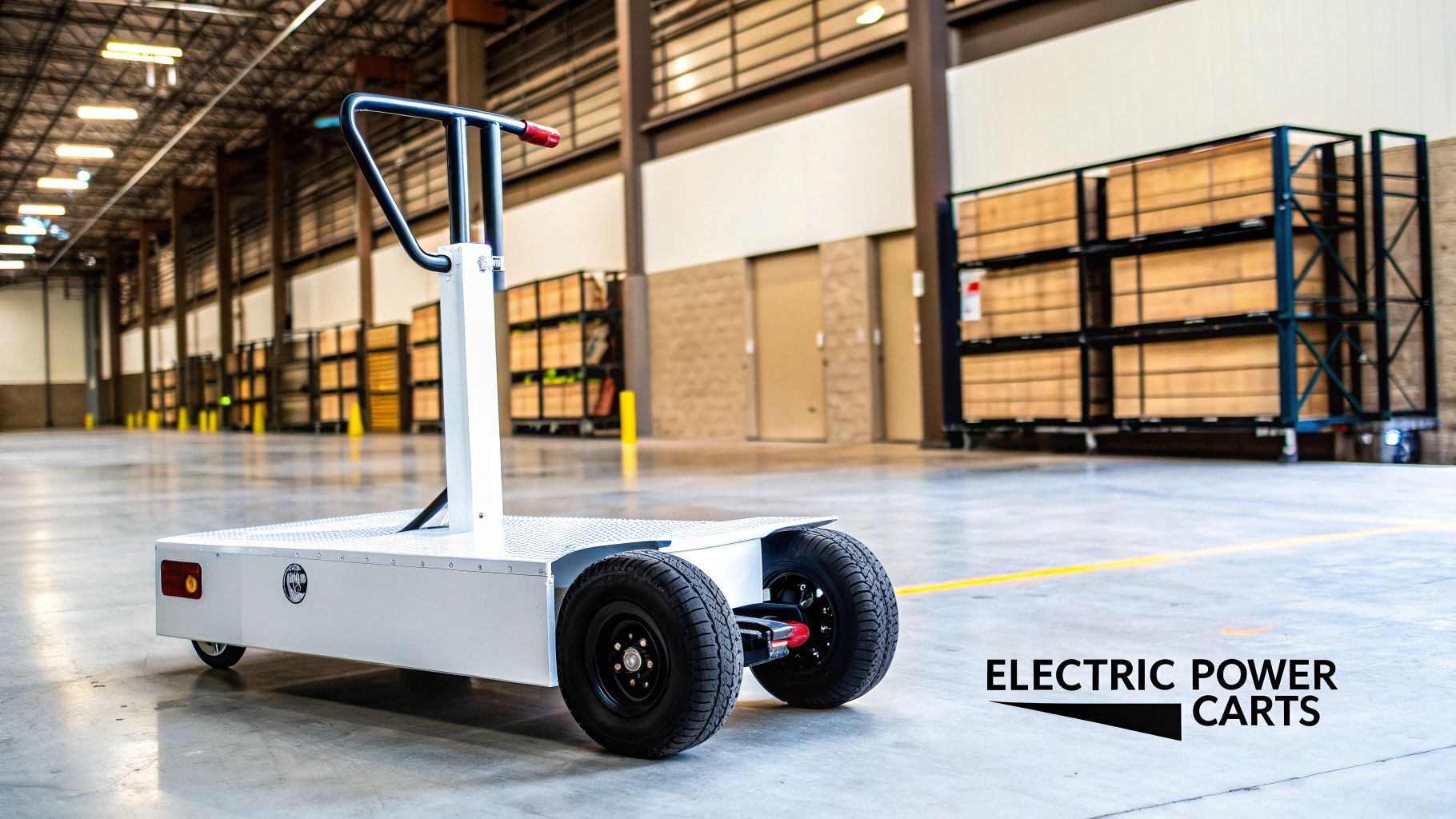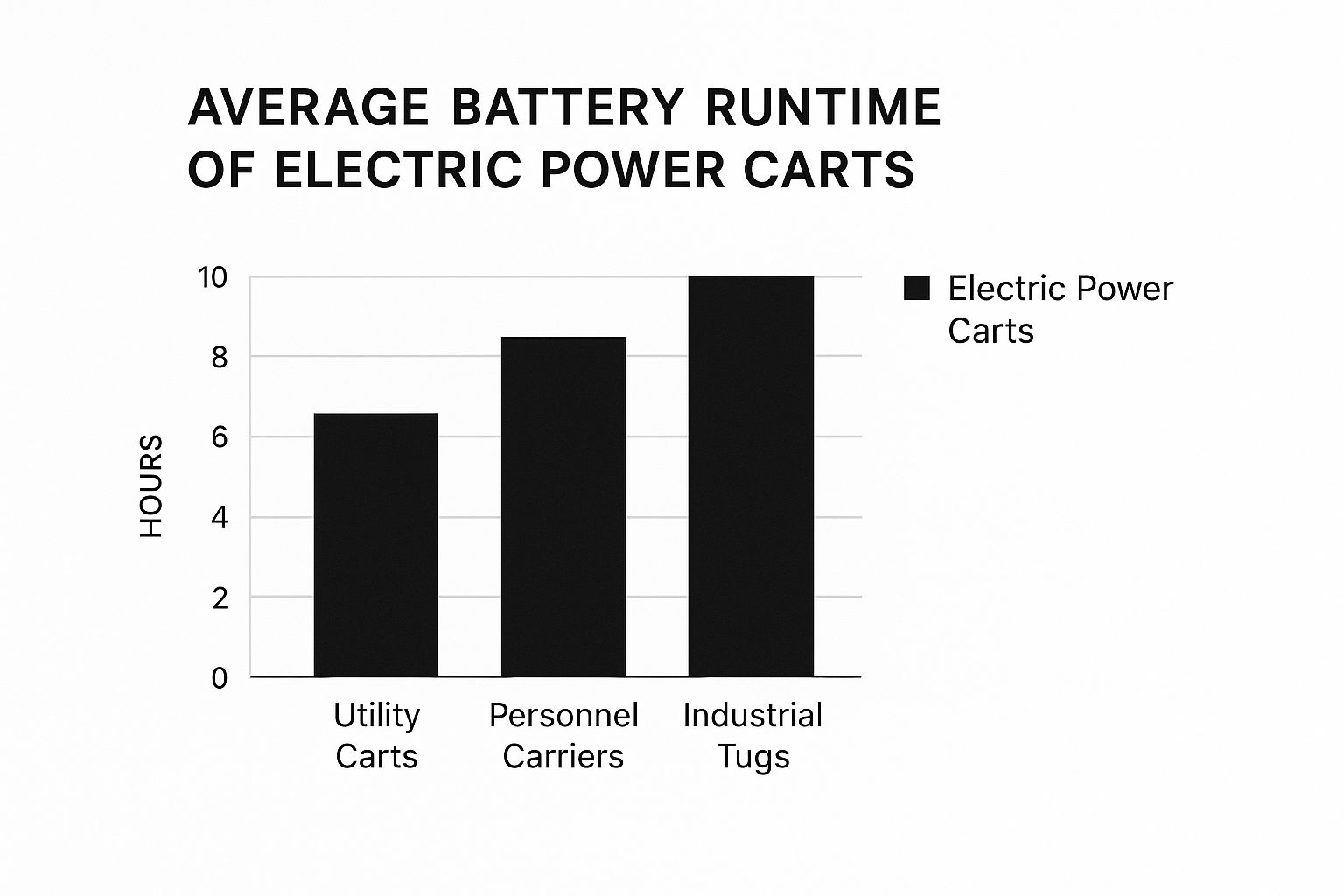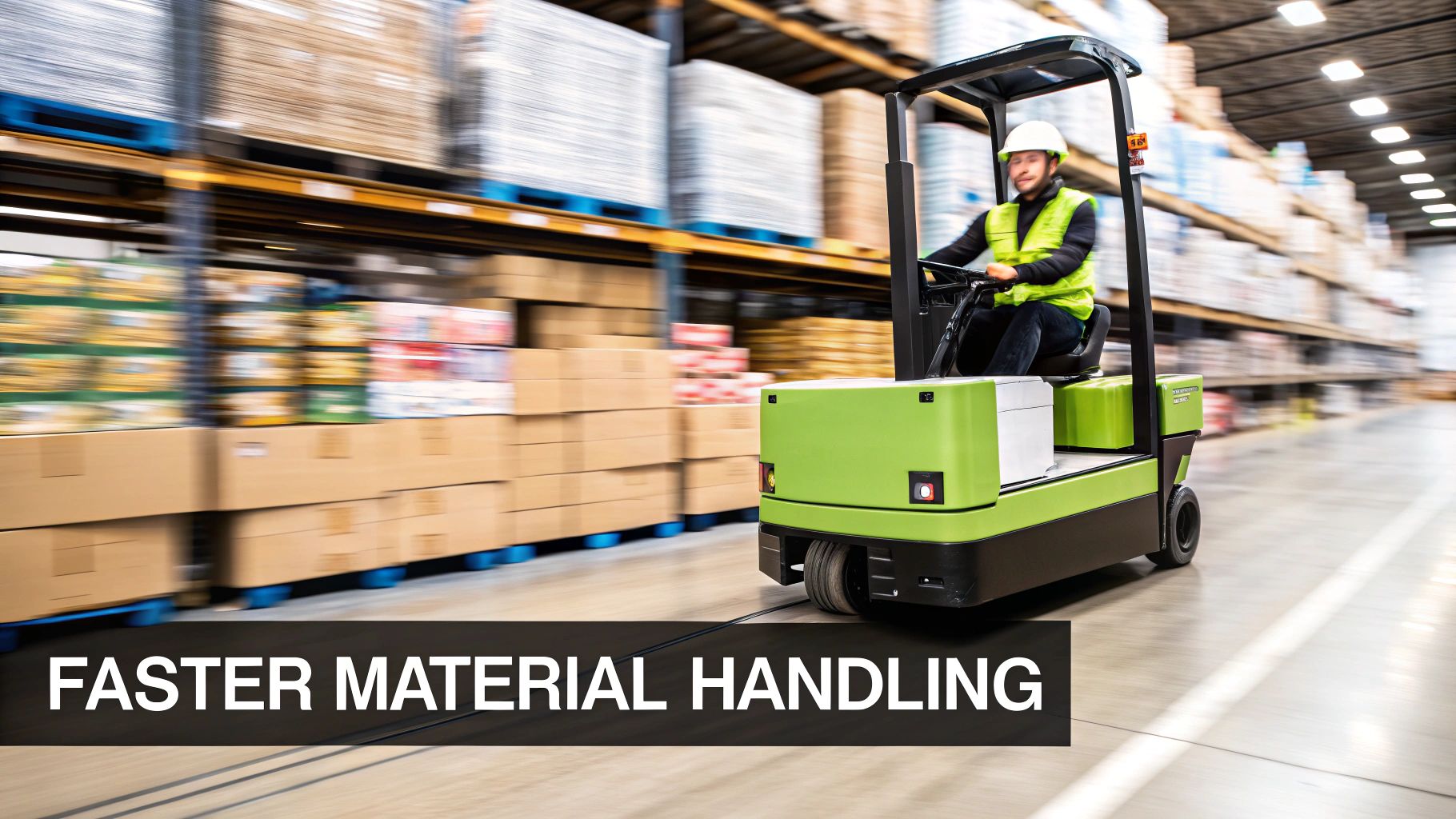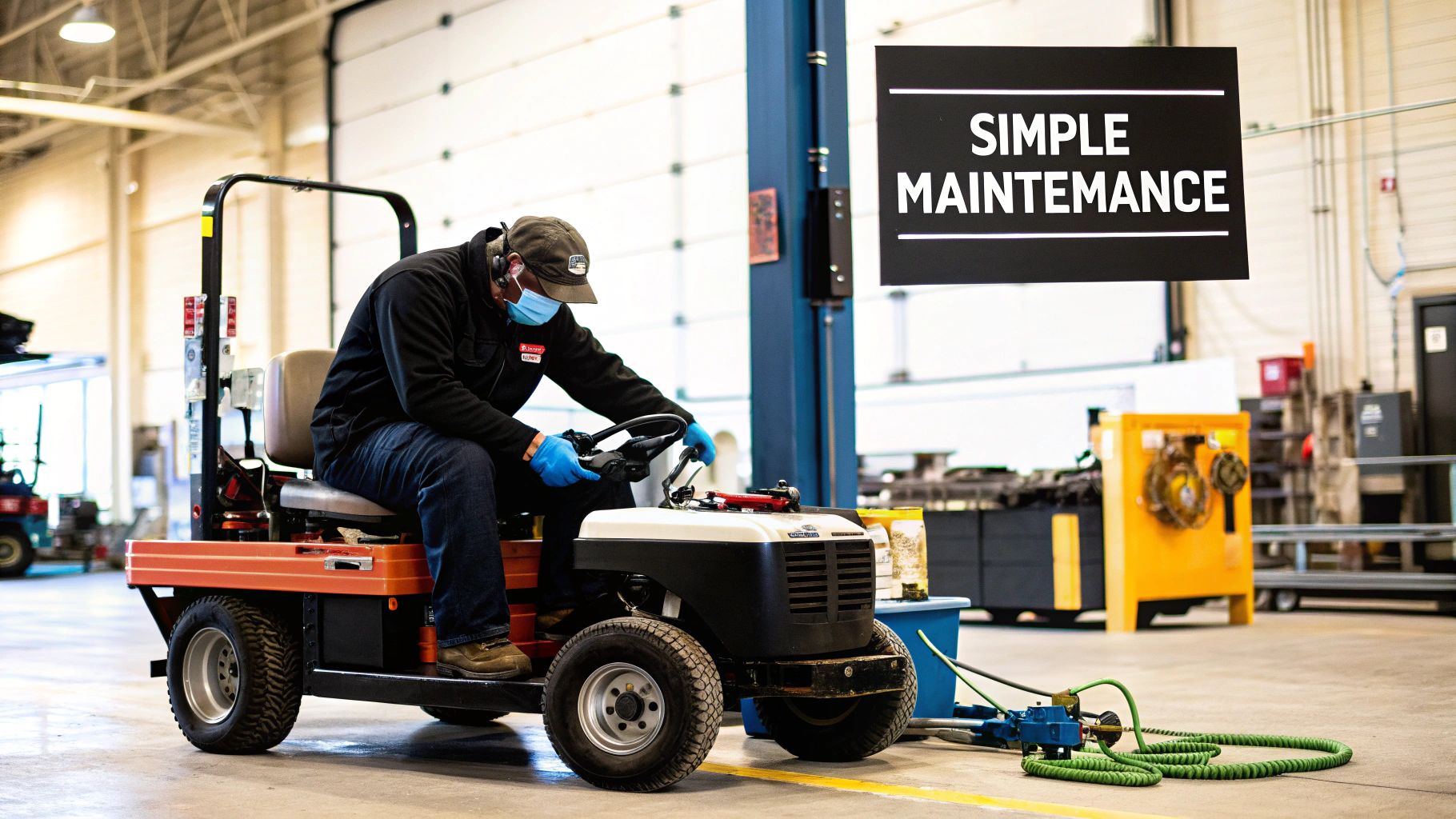Understanding Electric Power Carts in Today's World
When you hear "electric power cart," your mind probably jumps to a vehicle cruising down a golf course. While you're not wrong, that's only a sliver of the full picture. These days, electric carts have journeyed far beyond the fairway, becoming quiet workhorses in industries, communities, and commercial spaces. They’ve graduated from being just recreational toys to practical answers for real-world mobility needs.
Think of an electric power cart like the swiss army knife of short-distance travel. A standard car is built for one thing: driving on public roads over long distances. An electric cart, however, is a master of contained environments. Whether it's helping residents in sprawling retirement communities move around freely or cutting operational costs at a busy industrial park, these carts offer quiet, efficient, and eco-friendly transport where larger vehicles are simply impractical.
More Than Just a Golf Cart
The modern electric power cart has come a long way, thanks to big improvements in battery life and onboard technology. Today's carts pack surprising power, go farther on a single charge, and come in specialized designs for all sorts of jobs. This adaptability is a major reason why you’re seeing them pop up everywhere.
The global market for electric golf carts, a huge slice of the power cart pie, tells a compelling story. In 2024, the market was valued at around USD 1.13 billion. Projections show it’s set to nearly double, hitting approximately USD 2.03 billion by 2034. This growth isn't just about more golfers; it points to a broader shift toward smaller, cleaner electric vehicles for localized transportation. You can find more details about these market projections by exploring the growth of electric carts on PolarisMarketResearch.com.
This chart shows the expected growth in the electric golf cart market over the next decade.
 The clear upward climb highlights the rising demand for affordable and sustainable short-range mobility across many different sectors.
The clear upward climb highlights the rising demand for affordable and sustainable short-range mobility across many different sectors.
Categorizing the Modern Electric Power Cart
To truly get a handle on their usefulness, it helps to break these vehicles down into a few main categories. Just like a mechanic has different wrenches for different bolts, each type of cart is built with a specific purpose in mind.
- Personnel Transporters: These are the carts you see most often, designed simply to move people. They can be small two-seaters for personal use or multi-row "shuttles" that you might find at an airport, resort, or on a large college campus.
- Utility & Cargo Carts: Built to work, these models come with flatbeds or enclosed cargo boxes. They are the go-to vehicles in warehouses, for maintenance crews, and on farms, perfect for hauling tools, equipment, and supplies.
- Specialty Carts: This category covers vehicles modified for unique jobs. Think of a cart kitted out for food and beverage service on a golf course, one used for mobile security patrols, or even one equipped for emergency medical response at a large outdoor event.
Getting familiar with this landscape is the first step in seeing how an electric power cart could solve your specific needs, whether for personal freedom, business operations, or just for fun.
The Technology Behind Modern Electric Power Carts
If your memory of an electric power cart involves a sluggish vehicle struggling to climb a gentle hill, it’s time to rethink what’s possible. Today’s carts are less like their slow-moving ancestors and more like specialized, efficient transport tools. This leap forward isn't due to a single invention but rather a combination of powerful technologies that have improved performance, reliability, and intelligence. At the core of this change is a fundamental shift in how these vehicles are powered and managed.
The Power Core: From Lead-Acid to Lithium-Ion
For decades, the standard for any electric cart was the heavy, high-maintenance lead-acid battery. While it got the job done, it had clear drawbacks: slow charging, significant weight, and a shorter operational life. The move to lithium-ion batteries has been a game-changer, much like swapping an old, heavy tube television for a sleek, lightweight flatscreen.
These modern batteries charge faster, last much longer, and weigh considerably less, which directly boosts a cart’s range and hill-climbing power. This shift is part of a larger trend, with global demand for automotive lithium-ion batteries jumping by 65% in a single year, from 330 GWh in 2021 to 550 GWh in 2022. You can learn more about the growth of these technologies and their impact on electric vehicles in this market analysis from Polaris Market Research.
To better understand the differences, let's compare the two main battery types used in electric power carts. The following table breaks down how lead-acid and lithium-ion batteries stack up against each other in key areas.
| Battery Type | Lifespan | Charging Time | Range | Weight | Initial Cost |
|---|---|---|---|---|---|
| Lead-Acid | 500-1,000 cycles | 8-10 hours | Shorter | Heavy | Low |
| Lithium-Ion | 3,000-5,000 cycles | 2-4 hours | Longer | Lightweight | High |
This comparison makes it clear why lithium-ion has become the preferred choice for modern carts. While the initial cost is higher, the superior lifespan, faster charging, and lighter weight deliver far better performance and long-term value.
Intelligence on Wheels: Smart Systems and Connectivity
Beyond the battery, modern carts are packed with intelligent systems that improve both performance and the user experience. Regenerative braking, once a feature found only in high-end electric cars, is now common. Instead of losing energy as heat when you slow down, this system captures it and sends it back to the battery, extending the cart's range. It's like having a bicycle that pedals itself a little every time you go downhill.
Additionally, smart features are becoming standard, adding a new layer of convenience and control:
- GPS Tracking: Fleet managers can monitor vehicle locations in real-time, which helps with security and operational planning.
- Digital Dashboards: These screens give clear, immediate feedback on speed, battery life, and system diagnostics, removing the guesswork from operation.
- Smartphone Connectivity: Users can check battery status, locate their cart, or even get maintenance alerts directly on their phones.
The infographic below shows how different types of carts, powered by these advanced batteries, offer varied runtimes depending on their intended use.

As shown, industrial tugs are built for endurance with the longest runtime, a reflection of their demanding work environments. Even personal carts now deliver a full day of use, which is a significant improvement. While these technologies are transforming larger carts, similar principles are also making personal golf equipment better. You can discover more about the benefits of electric push carts for golfers in our detailed guide. These technological steps forward have made the modern electric power cart a more capable and reliable machine than ever before.
Real-World Applications Where Electric Power Carts Excel
 While the golf course is the classic home for the electric cart, its true value shines in a surprising number of everyday settings. These vehicles are quiet, effective problem-solvers that perform best where short-distance transport is critical, but a full-sized car or truck is just too much. From sprawling university campuses to busy logistics centers, the electric power cart has become a go-to tool for getting things done.
While the golf course is the classic home for the electric cart, its true value shines in a surprising number of everyday settings. These vehicles are quiet, effective problem-solvers that perform best where short-distance transport is critical, but a full-sized car or truck is just too much. From sprawling university campuses to busy logistics centers, the electric power cart has become a go-to tool for getting things done.
Enhancing Mobility and Independence
In large, self-contained areas, these carts are more than a simple convenience; they're a lifeline. Think about retirement communities, where residents want to maintain both their independence and safety. An electric power cart lets them visit friends, attend community events, and run daily errands without depending on others or dealing with a traditional car. For older adults, this can be a major factor in staying active and engaged. In fact, many senior golfers find that electric assistance on the course makes the game more enjoyable and physically manageable, a topic you can explore further in our guide on electric push carts as a game-changer for senior golfers.
This same idea applies to other large-scale environments:
- University Campuses: Maintenance crews use utility carts to move tools and supplies across vast grounds without disrupting student life with loud, polluting engines.
- Resorts and Hotels: Guest services can run quiet, emission-free shuttles to take visitors from their rooms to pools, restaurants, and parking lots, improving the overall guest experience.
- Medical Complexes: Carts offer essential mobility for staff, patients with limited mobility, and the transport of medical supplies between buildings.
Boosting Efficiency in Commercial and Industrial Settings
The effect of the electric power cart is especially clear in the business world. Warehouse supervisors, for example, have seen impressive results by adding electric utility carts. These vehicles allow one worker to safely and quickly move heavy materials that might have once required several people or a forklift. This helps reduce labor costs and the risk of workplace injuries.
This growing use is also seen in market trends. Electric platform carts, a wide category covering industrial and commercial models, have seen consistent market growth. This is largely fueled by the push for more automation in logistics and warehousing, where these carts help move goods efficiently while cutting down on labor and emissions. You can learn more about these industrial applications on Cognitive Market Research.
The chart below from Cognitive Market Research breaks down the electric platform cart market, showing its many uses.
 The data shows that industrial and commercial sectors are the main users, highlighting the vehicle's role as a serious tool for operational improvement. Whether it's a large retail store using carts for overnight restocking or a factory floor moving parts between assembly lines, the advantages are clear: increased productivity, lower operational costs, and a safer work environment.
The data shows that industrial and commercial sectors are the main users, highlighting the vehicle's role as a serious tool for operational improvement. Whether it's a large retail store using carts for overnight restocking or a factory floor moving parts between assembly lines, the advantages are clear: increased productivity, lower operational costs, and a safer work environment.
Essential Features That Separate Quality From Mediocrity
When you're looking at electric power carts, it’s easy to get lost in a list of specifications and marketing promises. But not all features are created equal, and knowing what actually matters can be the difference between buying a dependable workhorse and a costly headache. The trick is to look beyond the flashy numbers and focus on the components that directly affect real-world performance, durability, and safety.
Power and Performance Metrics That Matter
It's a common mistake to fixate on peak horsepower. While that number might look good on paper, torque is the more critical metric for most uses. Think of torque as the raw grunt that gets the cart moving from a dead stop and pulls it up a steep incline. This is far more important for day-to-day tasks than top speed. A cart with high torque will feel strong and responsive, especially when loaded down or climbing hills.
Just as important is the Battery Management System (BMS). Consider the BMS the "brain" of your battery pack. It’s not just a simple charger; it actively monitors and protects every cell from overcharging, draining too low, and overheating. A quality BMS can double the life of a lithium-ion battery, preventing early failure and saving you thousands in replacement costs. Without a good BMS, even the most expensive battery can wear out surprisingly fast.
Durability and Comfort Features
The true value of an electric power cart is also measured by its build quality and how it stands up to different environments. Key elements to look at include:
- Suspension System: A basic leaf spring suspension might be adequate for smooth, paved paths. However, for varied or rough ground, an independent suspension system delivers a much smoother ride and better handling, which reduces wear on the vehicle and is more comfortable for the operator.
- Payload and Towing Capacity: Always make sure the manufacturer’s stated capacity is a realistic match for your needs. Overloading a cart puts a major strain on the motor, brakes, and frame, which can lead to expensive repairs. A cart rated for 1,000 lbs will have a significantly stronger chassis and braking system than one rated for 500 lbs.
- Weather Resistance: Check for an IP (Ingress Protection) rating on the electrical parts. A higher rating, like IP67, means the motor and controller are sealed against dust and can handle being temporarily submerged in water. This is crucial for ensuring reliability in wet or dusty conditions.
To help you decide which features are most important for your needs, here's a checklist comparing essential components across different use cases.
Essential Electric Power Cart Features Checklist
A comprehensive overview of must-have features for different electric power cart applications, from basic recreational use to commercial applications.
| Feature Category | Basic Use | Commercial Use | Industrial Use | Priority Level |
|---|---|---|---|---|
| Performance | Standard Torque | High Torque for hills & loads | Maximum Torque for heavy loads | High |
| Battery | Standard Lithium-ion | High-Capacity Lithium-ion | Heavy-Duty Lithium-ion | High |
| BMS | Standard Protection | Advanced Monitoring & Protection | Sophisticated, cell-level control | Critical |
| Suspension | Leaf Spring | Independent Suspension | Heavy-Duty Independent | Medium to High |
| Payload | 300-500 lbs | 500-1,000 lbs | 1,000+ lbs | High |
| Braking | Standard Brakes | Automatic Braking System | Regenerative & Automatic Braking | Critical |
| Weatherproofing | Basic (IP54) | High (IP65+) | Sealed (IP67) | Medium to High |
| Safety | Basic Lights | LED Headlights, Taillights, Horn | Full Visibility Package, Speed Limiter | High |
This table shows how the demands on a power cart increase from simple recreational use to heavy industrial applications. While a basic user might not need an IP67 rating, it's a non-negotiable feature for commercial fleets operating in all weather conditions.
Safety and Operational Enhancements
Safety features should never be an afterthought; they are what separate premium models from basic ones. For instance, automatic braking systems engage the moment the accelerator is released, preventing the cart from rolling away on a slope. This is a vital safety feature for both personal and commercial environments.
Additionally, features like programmable speed limiting give fleet managers control over safe top speeds, which helps reduce the risk of accidents. An enhanced visibility package—including bright LED headlights, taillights, and turn signals—is essential for operating in low light or around other vehicles. While these might seem like small extras, they contribute significantly to safe and efficient daily use, justifying a higher initial price by ensuring long-term reliability and operator confidence.
Smart Buying Strategies From Industry Veterans
 Choosing the right electric power cart goes much deeper than just looking at spec sheets and price tags. Experienced fleet managers and savvy buyers know that real value is found beyond the initial purchase. They've learned—sometimes the hard way—that a thoughtful approach is crucial to getting a reliable vehicle that serves them well for years. This means looking past the flashy features to understand the complete picture of ownership.
Choosing the right electric power cart goes much deeper than just looking at spec sheets and price tags. Experienced fleet managers and savvy buyers know that real value is found beyond the initial purchase. They've learned—sometimes the hard way—that a thoughtful approach is crucial to getting a reliable vehicle that serves them well for years. This means looking past the flashy features to understand the complete picture of ownership.
The first step is to be honest about your own needs. It's easy to get drawn to a cart with the highest top speed or the most advanced dashboard, but will you actually use those features? A better method is to think like a teacher preparing for a field trip—practicality wins over bells and whistles every time. You need the right tools for the job, not just the fanciest ones.
Asking the Right Questions Before You Buy
A great dealer acts less like a salesperson and more like a consultant. Their main goal should be to find the perfect fit for your specific situation. To test their knowledge and the manufacturer's dependability, you should arrive with specific questions that go beyond the sales pitch. Here are a few essential questions to ask:
- "Can you explain the warranty terms for the battery, motor, and controller specifically?" A vague or short-term warranty on these essential parts is a major red flag.
- "What does your after-sales service and support look like?" You need to know where repairs are handled, how quickly you can get parts, and if they provide on-site service.
- "Based on my terrain and usage, what are the real-world range and maintenance costs?" A trustworthy dealer will give you realistic numbers, not just the ideal scenarios from the brochure.
These questions help you see the long-term commitment you're about to make and can help you tell the difference between reliable suppliers and those just looking for a quick sale. For anyone new to this market, building a solid foundation of knowledge is key. If you're just starting out, you might want to read our comprehensive guide on what to know before buying an electric golf push cart.
Calculating the Total Cost of Ownership (TCO)
The sticker price is just the start of your investment. The Total Cost of Ownership (TCO) gives you a much clearer financial picture. Smart buyers always figure out the TCO by adding up all the costs they expect to have over the vehicle's lifespan.
Think of it this way: a printer might be cheap, but the real expense is the ink cartridges you buy over the years. In the same way, an electric power cart’s TCO includes:
- Energy Costs: How much will you spend on electricity based on your expected use?
- Maintenance: Include scheduled servicing, new tires, and brake upkeep in your calculations.
- Insurance: Depending on where you plan to use the cart, you might need specific liability coverage.
- Battery Replacement: Even top-tier batteries don't last forever. Knowing the replacement cost for a quality battery is essential for long-term budgeting.
By looking at these factors, you can make a choice based on long-term value, not just what seems cheapest today. A slightly more expensive cart with a 5-year battery warranty and low maintenance requirements will often be a smarter financial decision than a cheaper model that needs a new battery in two years. This ensures your electric power cart is a solid investment that will provide reliable service for a long time.
Market Trends Shaping Electric Power Cart Innovation
The electric power cart industry isn't sitting still. Instead, it's being actively guided by powerful market forces and new demands from consumers. Think of these trends as a quiet but steady current, steering innovation, deciding which features become essential, and shaping what the next generation of carts will look like. Understanding these shifts is key to making a smart purchase that won’t feel outdated in a few years.
This momentum is reflected in the market's impressive growth. The market for golf carts and Neighborhood Electric Vehicles (NEVs), a category that includes many electric power carts, was valued at approximately $4.69 billion in 2024. Forecasts show it climbing to $5.12 billion by 2025 and are projected to reach $7.47 billion by 2029. These figures signal strong, sustained demand for smaller electric vehicles. You can discover more insights about this growing market on The Business Research Company.
The chart below shows the significant growth expected for the golf cart and NEV market.
This upward trend isn't just a number; it’s a reflection of deeper changes in how we approach short-distance transportation, driven by the key trends discussed below.
Sustainability and Smarter Energy Use
One of the most powerful trends is the push for greater sustainability, which now goes far beyond simply being battery-powered. Manufacturers are exploring smarter, greener solutions:
- Solar Integration: Some models are being designed with solar panels on their roofs. This feature allows the cart to trickle-charge while parked in the sun, reducing its reliance on the power grid and lowering operating costs. It’s like a plant soaking up sunlight—a slow but constant source of free energy.
- Eco-Friendly Materials: Forward-thinking companies are starting to use recyclable plastics and other sustainable materials in their construction, appealing to environmentally conscious buyers.
- Carbon-Neutral Manufacturing: The most committed brands are working to offset the carbon footprint of their entire production process, from sourcing materials to final assembly.
Connectivity and Fleet Management
For businesses, an electric power cart is no longer just a vehicle; it's a connected asset that can be managed with precision. Modern fleet management is being transformed by digital technology. Features like GPS tracking, remote diagnostics, and predictive maintenance alerts are becoming more common.
A fleet manager can now sit at a desk and see where every cart is, check its battery status, and get a notification if a motor is showing signs of potential failure. This allows for proactive repairs, minimizes downtime, and optimizes how the entire fleet is used. It turns a group of individual carts into a highly efficient, coordinated system.
New Markets and Compact Designs
Finally, fresh market opportunities are fueling a new wave of innovation. The rise of last-mile delivery services in crowded urban areas has created a need for small, nimble electric vehicles that can navigate tight streets and pedestrian zones. This has led to the development of more compact, efficient cart designs focused on cargo capacity and maneuverability.
Similarly, the growing trend of creating car-free zones in city centers and residential communities is opening up more space for vehicles like the electric power cart to serve as a primary mode of local transport. These new applications are pushing designers to create vehicles that are not only functional but also perfectly suited for the specific environments in which they operate.
Making The Right Choice For Your Specific Needs
Your journey to finding the perfect electric power cart shouldn't end in disappointment. With the right approach, you can move from researching options to making a confident purchase that truly fits your needs. The trick is to look past the flashy features and focus on practical value, ensuring the cart you pick is a real solution, whether for personal use or large-scale work.
Asking Questions That Reveal True Expertise
A good dealer or manufacturer should be more like a trusted advisor than a salesperson simply trying to move inventory. To tell the difference, you need to ask questions that dig deeper than the brochure. Think of it as an interview for the important job of supplying your transportation.
Here are a few key questions to start with:
- "Can you detail the warranty coverage for the battery, motor, and controller separately?" You're looking for strong, long-term coverage on these essential parts. A solid warranty, especially on the battery, shows the manufacturer is confident in their product's quality.
- "What is your process for parts availability and service calls?" Every moment your cart is out of commission can be costly. A reliable partner will have a clear, efficient system for getting you the parts and service you need, when you need them.
- "Based on my specific terrain and load requirements, what is the realistic daily range?" An honest dealer will consider factors like hills, weight, and frequent stops to give you a range you can actually count on, not just an ideal number.
Clear, direct answers are a great sign. If you get vague responses or the person tries to change the subject, consider it a red flag for potential issues later on.
Final Recommendations for Different Users
The best electric power cart changes depending on how you plan to use it. A common mistake is looking for a one-size-fits-all model, which often leads to frustration. Instead, match your choice to your main purpose.
- For Individual Recreational Users: Your focus should be on comfort, simple operation, and a reliable battery with enough juice for a full day of fun. Models with good suspension and easy-to-use controls are ideal.
- For Small Commercial Operations (e.g., Resorts, Campuses): Look for durability, safety features like automatic braking, and a good mix of passenger comfort and utility. A payload capacity of 500-800 lb is typically a great fit.
- For Heavy Industrial or Fleet Operators: Your top needs are maximum payload capacity (1,000+ lbs), high-torque motors for power, a rugged build, and advanced fleet management tools. A top-tier Battery Management System (BMS) is essential to protect your significant investment.
By carefully matching your needs to these profiles, you can avoid paying for features you'll never use or buying a cart that can't keep up with the demands of the job. This targeted method helps ensure you'll be happy with your choice for years to come.
If your main goal is simply to make your golf round less strenuous without buying a brand-new vehicle, there's a more direct solution. The Caddie Wheel provides a powerful, drop-on electric assist for the push cart you already own, giving you the power you need without the cost of a full cart. Explore how Caddie Wheel can transform your game today.
Article created using Outrank


Share:
Top Golf Electric Walking Carts of 2025 | Improve Your Game
Top 6 Electric Golf Cart Conversion Kit Options for 2025